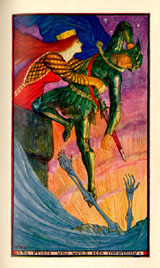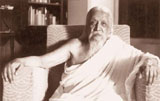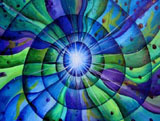Integral Health
The question of immortality
(The metaphysical foundation of Integral Health) The urge for immortality is innate in the human psyche. We need to understand it from four distinct perspectives:
(a) The spiritual and mystical traditions in India had the experiential realisation that consciousness per se could outlive the individual lifespan. The 2001 manifesto of the Scientific and Medical Network in U.K. postulated that some form of consciousness could survive brain death. It has of course been acknowledged in spiritual research that if an individual consciousness has been worked upon, developed intensely along one or several dimensions that range from intuitive creativity to titanic strength, then that consciousness can surpass not only the individual lifespan but also the constraints of space and time and continue to influence, stimulate and inspire susceptible individuals at different places, climes and eras. Thus the consciousness of Alexander, Socrates, Galileo, Columbus, Beethoven, Shakespeare and Leonardo da Vinci continue to inspire and shape the lives and activities of warriors, thinkers, scientists, explorers, musicians, litterateurs and artists throughout the world and throughout the ages. Such an inspiration might not be merely hypothetical; it can be a concrete presence in the consciousness, an internal energiser, a motivator to replicate, innovate and act out ideals and values in consonance with the Time-Spirit.
(b) The spiritual heritage of India also produced exceptional individuals who developed the art of voluntarily ‘willing’ one’s death by soulchoice through yogic endeavour. Through a technology of consciousness, this capacity can be universalised and made more commonly accessible and applicable. Such a unique quality would serve two purposes. Firstly, even if physical immortality was attainable, one could yet be weary of the same bodily frame and personality make-up which anyway need to change and adapt to new challenges in Time. Secondly, the cultivation of ‘willing’ one’s death from the soul-poise of a deeper or higher consciousness can help humanity in general to make a reappraisal of the phenomenon of suicide and medical science in particular to reformulate its policy on euthanasia. Suicide is a vital recoil from life abetted by elements in the subconscious and reinforced by extraneous factors and forces. Euthanasia is a grey area where it is difficult to resolve moral dilemmas. In passive euthanasia, the decision to de-link the life-support system from an unconscious subject is based on uncertain assumptions. In active euthanasia, the subject in agony opts for a conscious choice that can arise from a vital impulse and may not be in consonance with the soul-choice or Divine Will. The development of soul-choice for the voluntary ‘willing’ of death has to be supplemented by the development of the capacity of intuitive discrimination on the part of therapists to construct a framework of reference for euthanasia.
(c) The immortality of the soul in sharp contrast to the mortality of the bodily frame has been experientially perceived and realised in the Indian spiritual tradition. To appreciate this phenomenon, one has to reach out to a beyond-ego principle in the centre of one’s being. This is the immutable element of divinity in an otherwise mutable frame. Sri Aurobindo considered this to be that aspect or poise of the soul that takes part in evolutionary manifestation and named it as the Psychic Being that complements the unevolved aspect of the soul (Jivatman or Central Being) poised above the manifestation. The Psychic Being gathers the essence of the peak experiences in a lifetime and survives death of the individual. The essences of life’s experiences are thus preserved in the cosmic consciousness as memory traces. If a particular creation dissolves and a new cycle of creation starts, then the memory traces left from previous cycles can act as initiating points. Thus the immortality of the soul carries the thread of continuity through the perpetual recurrence of the cycles of creation. The Psychic Being is also the harbinger of health and well-being. It surpasses the divisive experiences of the ego to impart a sense of wholeness, integrality, peace and joy even in the midst of adversities. The quintessence of Integral Health lies in a shift from the skewed experiences of the ego and the disharmony of the outer being to the wholistic, integralist, harmonious and joyous consciousness of the Psychic Being.
(d) Sri Aurobindo adds an important dimension to the quest for immortality — the perpetuation of the present species of homo sapiens. Our human species is endangered from several directions. Firstly, there is the cosmic law of dissolution that alternates with creation. Secondly, the ecological exploitation of the planet has its inherent ramifications. Thirdly, the human species has its own self-destructive propensities and techniques. Sri Aurobindo advocates that the only way to outlive the habitual limitation of forms is an evolutionary growth in consciousness that secondarily influences the biological evolution to manifest higher and higher models of human being till the highest creative consciousness ( which he termed as ‘Supramental’) is embodied in earthly terms.
However, this involves a paradigm shift in the context of evolution. The paradigm shift has to be considered from two perspectives:
1.Though evolution as a phenomenon manifested de novo from the matrix of consciousness, yet outwardly the evolution of forms preceded the evolution of consciousness till the appearance of the human being. The human being did not wait to be erect till the brain developed. Anthropological evidence suggests that man first stood up, the hands became free for instinctive innovations and subsequently the brain size increased. Thus the development of form preceded the development of consciousness. However, if evolution has to proceed beyond the present human form, then the mutation in consciousness has to precede the mutant changes in form.
2. The biological evolution proceeded automatically and spontaneously up to the appearance of humans, propelled by universal forces in nature. But a further evolutionary growth requires the involvement of two new forces. The first is the conscious collaboration of the human being who has been given the capacity for thought, the potentiality of willpower, the quality of receptivity and the aspiration for progress. The second is the influence of the highest creative Supramental consciousness that is necessary to break the resistance of the Inconscience and the rigidities of the lower nature.
The paradigm shift thus leads to a transformation of the lower nature in terms of the Higher Nature. To be capable of transformation, the consciousness embodying the present human form has to be optimally organised. The discordant parts and planes of consciousness have to be integrated around the fourth dimensional principle, the Psychic Being. Such integrated individuals are necessary to meaningfully traverse the hierarchies of consciousness.
Integral health is a poise of consciousness that is centered in the Psychic Being. It not only harmonises the discordant parts of the being around a deeper principle but also facilitates the subtle matter of the body to be flexible and responsive to the magic wand of transmutation.
Share with us (Comments, contributions, opinions)
When reproducing this feature, please credit NAMAH, and give the byline. Please send us cuttings.



